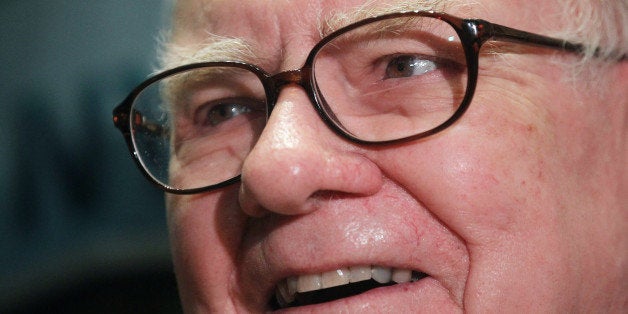
You've probably seen the headline - Warren Buffett Tells You How to Turn $40 Into $10 Million - heck, it's all over the web.
Who can resist the opportunity to turn what is basically pocket change into a multimillion dollar fortune - especially when the advice comes from such a respected source as Warren Buffett.
What's the story, and is it legitimate? Actually, it's quite legitimate - with a few caveats.
The $40 Stock Story
The legendary Berkshire Hathaway Chairman and CEO Warren Buffett made an observation a few years ago about an investment in Coca-Cola. He noted that if a person bought $40 worth of Coca-Cola stock when it first went public back in 1919 it would now be worth more than $5 million. And that reflects not only the growth in the price of the stock, but also stock splits and of course dividends.
A few years after he made that observation, Coca-Cola's Board of Directors updated that figure to report that the original $40 investment would be worth $9.8 million as of 2012. More recently, it works out to be $10.8 million.
So as it happens, the story is actually true. It would indeed have been possible to turn $40 invested in Coca-Cola stock in 1919, hold it, and watch it grow to over $10 million today.
The $40 Stock Story is An Advertisement
Alas, while the story is true, it is nonetheless a sponsored post put out all over the web by The Motley Fool. They are using the story as a draw to get you take a look at other stocks that they believe have similar potential.
Are investments in those stocks the best money-making strategies the world has ever seen? Possibly, but the odds are against it.
The Difficulty of Duplicating The Coca-Cola Story
Even though the Coca-Cola story is completely legitimate, the odds of duplicating that result are incredibly small.
- The Coke story "works" because it is an historic fact
- There were other stocks that went public in 1919 and didn't do nearly as well; some no longer exist and have fallen into the dustbin of history
- Few could have predicted that Coca-Cola would be around by the 21st Century, let alone that it would be such a spectacular investment
- Thousands of companies have come and gone since 1919, and only a very tiny percentage have seen anything even close to the results for Coca-Cola
- The incredible returns on Coca-Cola stock have developed over substantially more than the average human lifespan
- A lot of financial experts claim to know what the next Coca-Cola will be, but in the way that reality works, almost none of them will be right
We Don't Have a 100 Year Investment Horizon
Even if it were possible to know now what the next Coca-Cola would be, none of us have 100 years to wait around to find out if the stock will play out in that way.
If you are very young, you may have a 50 year investment time horizon, but the vast majority of us have something considerably less.
That may be more important than it sounds at first. The compounding effect of money has its greatest impact in the later years. For example, if a stock investment doubles from $1,000 to $2,000 in the first decade, that won't be nearly as impressive as a doubling from $1 million to $2 million between years 90 and 100. The greatest gains by dollar value will occur in the last few decades.
There's also the fact that you could invest in 20 different stocks, each reputed to be "the next Coca-Cola", but not a single one rising to that level. It's the chance that every investor takes with any investment. There's simply no way to know for certain that any stock will perform up to its expectations.
But there is a way to invest in stocks that can help you to reach financial freedom, even if it doesn't enable you to turn $40 into $10 million.
Using Mutual Funds to Get Similar Results
The average return on stocks has been somewhere between 9.60% and 11.53% between 1928 and 2014. That's a wide spread, so let's just use 10% as a rough mid-point of the average return we can expect over the very long term.
Assuming that you have a 50 year time horizon, and an annual stock market return of 10%, an investment today of $1,000 - in an S&P 500 index fund - could grow to about $117,000.
Now if you had 100 years to invest, the investment could grow to over $10 million. But since no one has a 100 year investment horizon it's kind of a moot point.
Still, growing your money by a factor of over 100 in a completely passive investment is an outstanding deal. And you can do just that with an index fund and at least 50 years, and do so with relative certainty.
What Can We Learn From This
Beyond investing in mutual funds, there are some solid lessons from the Coca-Cola story.
Look for strong products. Coca-Cola has proven to be such a successful investment because it is an excellent product. The company had grown considerably before it even went public, and continued to grow after 1919, despite the Great Depression, World War II, and all of the changes and competition that have come up since. You have to find a company with similar prospects if you hope to come close to duplicating the Coca-Cola investment return.
Be a long-term investor. Warren Buffet noted that the investment in Coca-Cola would have resulted from buying the stock all the way back in 1919, and holding onto it ever since. Few investors have that kind of patience. (And for the record, Warren Buffett wasn't born until 1930.) It is likely that there were times when Coca-Cola stock went in the tank, and experts considered it to be finished. You have to hold through such episodes, and few people do.
Diversification is the order of the day. The likelihood that you'll find THE stock that will have a similar performance is close to zero. The only way you could even hope to do so would be to invest in a portfolio of stocks that have similar potential. That might be a mix of 10, 20, 50, or even 100 stocks, in the hopes to just a few of them will fulfill the promise. If you're going to buy that many stocks, you may as well invest in a mutual fund.
At least in theory, it's possible to identify and invest in the next Coca-Cola. But you may not have the time horizon, or the patience, and it's quite possible that the would-be star stock ends up crashing and burning. But you can invest in an index fund, then step back, relax, and trust that the historic returns of the market will apply in the future.
That might not make you a multimillionaire, but it can still make you awfully comfortable.
